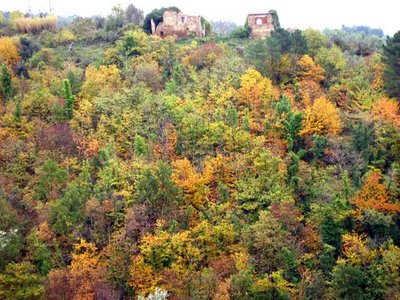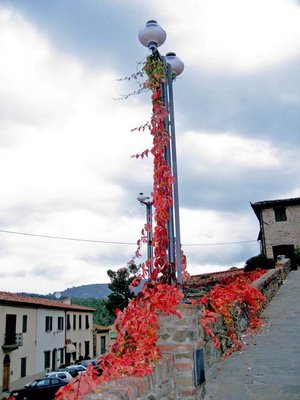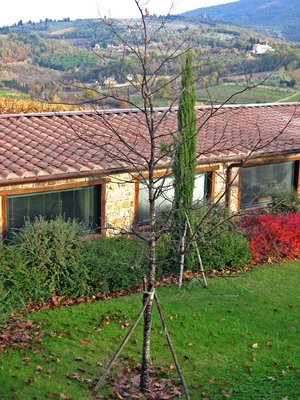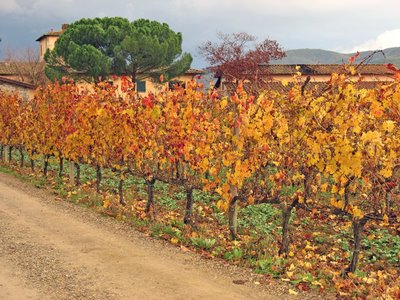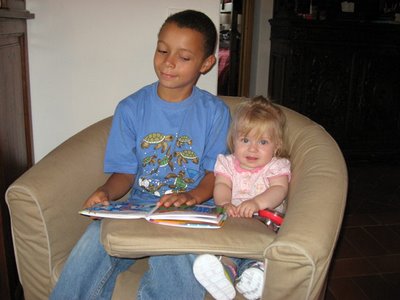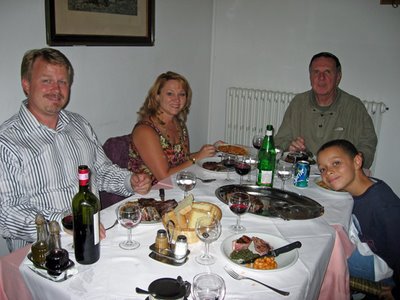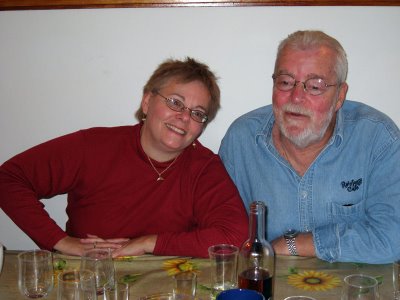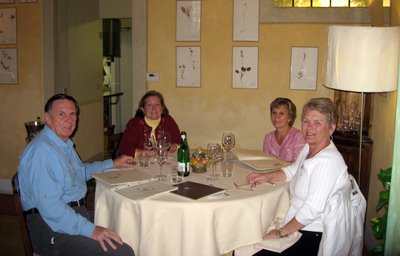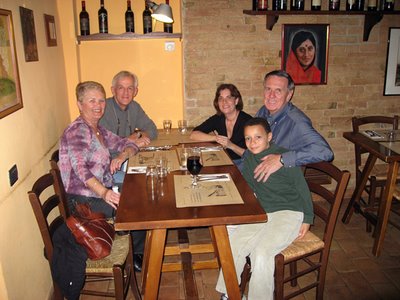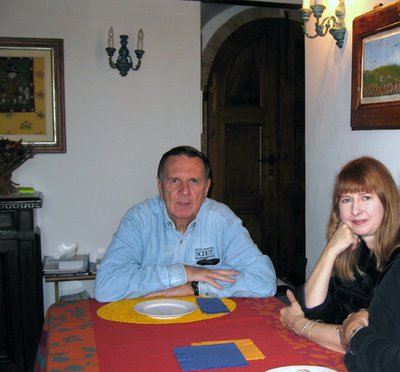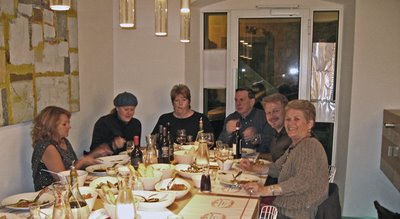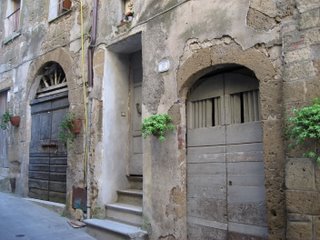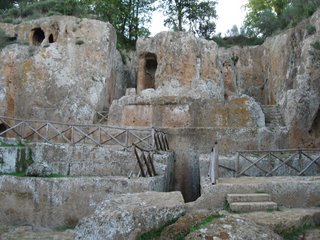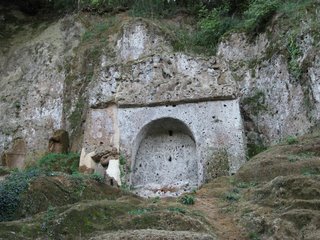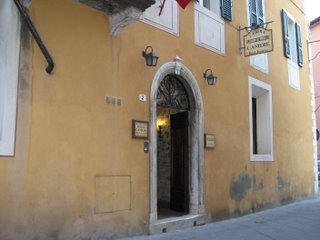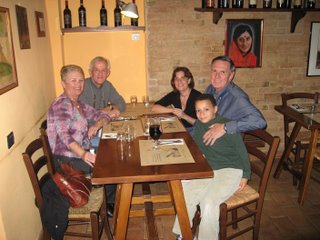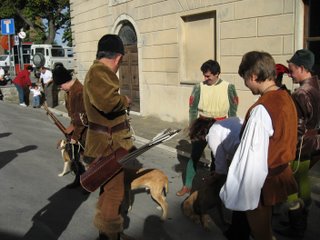Several posts past I wrote about the Italian classroom and the many differences between here and the technology rich classrooms in San Diego--discrepancies that have not altered--nor will they for the predictable future.
But now I share a little about Casey's teachers and instructions as the poverty of glitz does not always tell the whole story and in this case it doesn't.
Maestre Anna Maria and Agatha care about their children just as Mrs. Hanna, Mrs. Kang and other committed teachers at Marvin Elementary School in San Diego do. They want their students to learn, to be good citizens, to be prepared for the future that lies ahead, to be happy and successful. They want to influence and impact lives for the good.
The children have hands-on, exploratory learning experiences--they leave the confines of the school ground to take walks, studying the leaves and foliage and then return to the classroom to learn about photosynthesis. They bring needle and thread and ribbon and red socks to school to make Christmas gifts. They walk to the nearby cinema to see a movie and just have fun during the school day. They take field trips to far away museums to learn to appreciate art and creativity. They are taught all those things that are important in developing an educated person--math, geography, science, literature, history, art, music, etc.
For a while I was quite upset--in fact, very upset, because Casey was expected to participate in English language instruction--What color is the sky? What are the days of the week? One, two, three.... Clearly, this was a major waste of his learning time. He asked the teacher if he could read one of his English story books and was told no. Finally, I wrote a note, explaining that Casey would be returning to the United States next year and that it was important that he continue to develop his reading skills. Now he is allowed to read; although, more often, one of the teachers takes him during that time and works with his italiano--which is "va bene" or a good use of the time. The children have English instruction just two times a week and so fluency isn't much of an issue.
Math is difficult which comes as a real surprise. Since math is a universal discipline, we thought that Casey would find a lot of success in this area--particularly as he had a perfect score of 600 on last year's California Achievement Test in math. But--we have learned the theory that a rose is a rose is a rose does not apply to math. Processes for getting to answers are very different and, to us, unnecessarily complex.
Since the philosophy in Italy appears to be conformity and didactic instruction with minimal allowance for variation or creative thinking, there is more focus on process than result. Casey is finding this difficult as he has been taught to think independently and inductively. Actually, we agree that process is important; the problem lies in the reality that more than one process can be used to reach an answer. Casey uses processes he has learned which are logical, clear and successful. He is finding it hard to learn new ways as he finds it difficult to follow the formal italian used in instruction and because, he expects himself to do well, he gets very emotional and distraught over this. Currently he is very discouraged because he is going to get "sufficiente" on the upcoming grading period. This is not a good grade--at all.
Another big difference, again due to the focus on structure and conformity, is seen in the current science test--the measurement for the grade report. In the US Casey loves making reports and standing in front of the class to give them. In fact, he usually has more "up front" time than other students. Last year he was even teaching his classmates an italian vocabulary word a day.
For this science test, students are expected to memorize a rather lengthy description of photosynthesis which they have written in italiano in their notebooks (2 pages worth). They then are to stand and recite it to the class. Casey is devastated as he cannot memorize the assignment because the words and syntax are totally unfamiliar to him. He literally began to shake when he told us about it--again, demoralized because of fear of another "sufficiente." In English he can give a very thorough explanation of photosynthesis using his own words so he clearly understand the concept and can apply it.
Today he is going to ask Signora Anna Maria if he can read it rather than recite. If she says no, then we will need to go in and see what can be done. We can't let his self-concept or motivation be damaged just because we have put him in this situation.
In our minds, the teachers should be making allowance for the fact that 3 months ago Casey spoke no conversant Italian and that today he can chatter away--not always grammatically correct but he's getting there. Unfortunately, it may be that the standard for him doesn't deviate from the other students--which would very much be in keeping with the insistence on form over substance here. So, next week when we have our parent conference--which is the way grades are communicated--we will find out if his fears are justified or if Signora Anna Maria and Signora Agatha are more flexible than we anticipate. I certainly hope so!!!!
Now to be fair to them as teachers and persons--they both make it very clear that they enjoy and like Casey, but then, who doesn't? They write "bravo" on papers. They pat him on the head. Signora Anna Marie even gives him little hugs and kisses. So we are not talking about unfeeling, cold people--it is the system that seems not to have made room for the motivation and learning techniques that the American system recognizes and uses. As I have said before, I would love to offer training in teaching techniques, motivation and class management and I am pretty confident that it would be well received by the teachers.
Now--for those of you who do not visit Casey's blog, this video will give you an idea of how he tries and what he is accomplishing--and what he can do when given some leeway. This is his story in Italian. The translation into English follows the video Enjoy.
The Ghost of Viticcio
In 2006 I was at Viticcio in my room when the ghost arrived in my room. He was funny.
At a certain point the lights went out in my house and the window opened and a big owl entered my room and I was scared.
I turned all the lights on and then there was nothing left and the window was closed.
MYSTERY!!
Viticcio is where I live.
But now I share a little about Casey's teachers and instructions as the poverty of glitz does not always tell the whole story and in this case it doesn't.
Maestre Anna Maria and Agatha care about their children just as Mrs. Hanna, Mrs. Kang and other committed teachers at Marvin Elementary School in San Diego do. They want their students to learn, to be good citizens, to be prepared for the future that lies ahead, to be happy and successful. They want to influence and impact lives for the good.
The children have hands-on, exploratory learning experiences--they leave the confines of the school ground to take walks, studying the leaves and foliage and then return to the classroom to learn about photosynthesis. They bring needle and thread and ribbon and red socks to school to make Christmas gifts. They walk to the nearby cinema to see a movie and just have fun during the school day. They take field trips to far away museums to learn to appreciate art and creativity. They are taught all those things that are important in developing an educated person--math, geography, science, literature, history, art, music, etc.
For a while I was quite upset--in fact, very upset, because Casey was expected to participate in English language instruction--What color is the sky? What are the days of the week? One, two, three.... Clearly, this was a major waste of his learning time. He asked the teacher if he could read one of his English story books and was told no. Finally, I wrote a note, explaining that Casey would be returning to the United States next year and that it was important that he continue to develop his reading skills. Now he is allowed to read; although, more often, one of the teachers takes him during that time and works with his italiano--which is "va bene" or a good use of the time. The children have English instruction just two times a week and so fluency isn't much of an issue.
Math is difficult which comes as a real surprise. Since math is a universal discipline, we thought that Casey would find a lot of success in this area--particularly as he had a perfect score of 600 on last year's California Achievement Test in math. But--we have learned the theory that a rose is a rose is a rose does not apply to math. Processes for getting to answers are very different and, to us, unnecessarily complex.
Since the philosophy in Italy appears to be conformity and didactic instruction with minimal allowance for variation or creative thinking, there is more focus on process than result. Casey is finding this difficult as he has been taught to think independently and inductively. Actually, we agree that process is important; the problem lies in the reality that more than one process can be used to reach an answer. Casey uses processes he has learned which are logical, clear and successful. He is finding it hard to learn new ways as he finds it difficult to follow the formal italian used in instruction and because, he expects himself to do well, he gets very emotional and distraught over this. Currently he is very discouraged because he is going to get "sufficiente" on the upcoming grading period. This is not a good grade--at all.
Another big difference, again due to the focus on structure and conformity, is seen in the current science test--the measurement for the grade report. In the US Casey loves making reports and standing in front of the class to give them. In fact, he usually has more "up front" time than other students. Last year he was even teaching his classmates an italian vocabulary word a day.
For this science test, students are expected to memorize a rather lengthy description of photosynthesis which they have written in italiano in their notebooks (2 pages worth). They then are to stand and recite it to the class. Casey is devastated as he cannot memorize the assignment because the words and syntax are totally unfamiliar to him. He literally began to shake when he told us about it--again, demoralized because of fear of another "sufficiente." In English he can give a very thorough explanation of photosynthesis using his own words so he clearly understand the concept and can apply it.
Today he is going to ask Signora Anna Maria if he can read it rather than recite. If she says no, then we will need to go in and see what can be done. We can't let his self-concept or motivation be damaged just because we have put him in this situation.
In our minds, the teachers should be making allowance for the fact that 3 months ago Casey spoke no conversant Italian and that today he can chatter away--not always grammatically correct but he's getting there. Unfortunately, it may be that the standard for him doesn't deviate from the other students--which would very much be in keeping with the insistence on form over substance here. So, next week when we have our parent conference--which is the way grades are communicated--we will find out if his fears are justified or if Signora Anna Maria and Signora Agatha are more flexible than we anticipate. I certainly hope so!!!!
Now to be fair to them as teachers and persons--they both make it very clear that they enjoy and like Casey, but then, who doesn't? They write "bravo" on papers. They pat him on the head. Signora Anna Marie even gives him little hugs and kisses. So we are not talking about unfeeling, cold people--it is the system that seems not to have made room for the motivation and learning techniques that the American system recognizes and uses. As I have said before, I would love to offer training in teaching techniques, motivation and class management and I am pretty confident that it would be well received by the teachers.
Now--for those of you who do not visit Casey's blog, this video will give you an idea of how he tries and what he is accomplishing--and what he can do when given some leeway. This is his story in Italian. The translation into English follows the video Enjoy.
The Ghost of Viticcio
In 2006 I was at Viticcio in my room when the ghost arrived in my room. He was funny.
At a certain point the lights went out in my house and the window opened and a big owl entered my room and I was scared.
I turned all the lights on and then there was nothing left and the window was closed.
MYSTERY!!
Viticcio is where I live.
